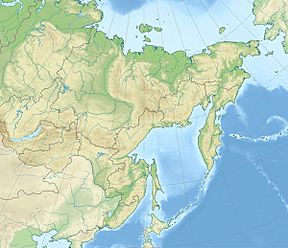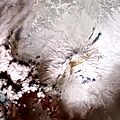Shiveluch facts for kids
Quick facts for kids Shiveluch |
|
|---|---|

Shiveluch from space, July 2007.
|
|
| Highest point | |
| Elevation | 3,283 m (10,771 ft) |
| Prominence | 3,168 m (10,394 ft) Ranked 73rd |
| Listing | Ultra |
| Geography | |
| Location | Kamchatka, Russia |
| Parent range | Eastern Range |
| Geology | |
| Age of rock | late Pleistocene |
| Mountain type | Stratovolcano (active) |
| Last eruption | 1999 to 2022 (ongoing, non-stop) |
| Climbing | |
| Easiest route | basic rock/snow climb |
Shiveluch (Russian: Шивелуч) is a very active volcano in Kamchatka Krai, Russia. Its name comes from the word "suelich," which means "smoking mountain" in the Itelmen language. It is the northernmost active volcano in Kamchatka.
Shiveluch is one of the biggest and most active volcanoes on Earth. It erupts constantly, sending out about 0.015 cubic kilometers (0.0036 cubic miles) of melted rock, called magma, each year. These eruptions often cause fast-moving flows of hot ash and gas, known as hot avalanches. They also create new lava domes at the top of the volcano. The ash clouds from Shiveluch can be so big that they affect airplanes flying between Asia and North America.
Contents
Where is Shiveluch Located?
Shiveluch is part of a group of volcanoes called the Kliuchevskaya volcano group. It is in the central part of Kamchatka. The volcano is about 84 kilometers (52 miles) northwest of a town called Ust-Kamchatsk.
The closest town to Shiveluch is Klyuchi, which is about 50 kilometers (31 miles) away. Klyuchi is a small town, so if a very big eruption happens, people can be moved to safety quickly.
How Does Shiveluch Form?
Shiveluch is a volcano in the Kuril–Kamchatka volcanic arc. This arc is a long chain of many volcanoes. It forms because the Pacific Plate is slowly sliding underneath the Okhotsk Plate.
When one plate slides under another, it's called subduction. As the Pacific Plate goes deeper, the rocks and minerals underground get very hot. Water and other materials help these rocks melt, forming magma. This hot magma then rises to the surface, creating volcanoes like Shiveluch.
What is Shiveluch Made Of?
Shiveluch is a type of volcano called a stratovolcano. This means it is built up from many layers of hardened ash, lava, and volcanic rocks. It has three main parts:
- Old Shiveluch (Старый Шивелуч): This is the oldest part of the volcano.
- An ancient caldera: This is a large, bowl-shaped hollow left behind by a huge eruption long ago.
- Young Shiveluch (Молодой Шивелуч): This is the active part of the volcano, and it is about 2,800 meters (9,200 feet) tall.
Shiveluch is one of the largest and most active volcanic structures in Kamchatka.
When Did Shiveluch Start?
Shiveluch began to form a very long time ago, about 60,000 to 70,000 years ago. Since then, it has had at least 60 large eruptions.
Some of the busiest times for eruptions were around:
- 6500–6400 BC
- 2250–2000 BC
- AD 50–650
These times also saw a lot of activity in other volcanoes in Kamchatka. The current period of constant eruptions started around 900 BC. Since then, big and medium-sized eruptions have happened every 50 to 400 years.
Very powerful eruptions happened in 1854 and 1957. In these events, a large part of the lava dome at the top of the volcano broke apart. This caused a huge and destructive flow of rock and debris.
The most recent eruption of Young Shiveluch began on August 15, 1999. It has been erupting non-stop ever since. For example, on February 27, 2015, Shiveluch sent ash 9,100 meters (30,000 feet) into the air. This ash cloud traveled across the Bering Sea all the way to Alaska. Another eruption happened on April 11, 2023.
Images for kids
-
The heat signature of a pyroclastic flow on Shiveluch in January 2011
See also
 In Spanish: Shiveluch para niños
In Spanish: Shiveluch para niños











